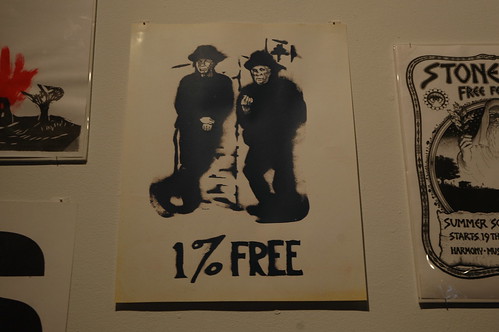Historical Item
A Spray Paint History Primer
The Origin of Spray Paint
By HILARY GREENBAUM and DANA RUBINSTEIN
Original NYTimes link: http://www.nytimes.com/2011/11/06/magazine/who-made-spray-paint.html
That a paint salesman from northern Illinois created the tool through which rebels, gang members, artists and anti-Wall Street protesters alike have expressed themselves merely confirms that inventors can neither control nor predict the impact of their innovations. After all, Jack Dorsey never imagined that Twitter would facilitate Anthony Weiner’s self-immolation.
The spray-paint can, however, has eminently practical origins. Ed Seymour, the proprietor of a Sycamore, Ill., paint company, was in search of an easy way to demonstrate his aluminum coating for painting radiators. His wife suggested a makeshift spray gun, like those used for deodorizers. And so, in 1949, Seymour mixed paint and aerosol in a can with a spray head…
Read moreNYC Tagger Neo was also NYPD
Graffiti legend was also an NYPD cop
By KATHIANNE BONIELLO
Last Updated: 11:24 AM, November 6, 2011
Posted: 9:34 PM, November 5, 2011
Police have discovered the identity of one of New York City’s most prolific graffiti vandals -- and he’s one of their own.
Steven Weinberg, 43, of Flushing, a patrolman who retired from the NYPD in 2001 after hurting his leg, is the notorious “Neo” -- one of the peskiest subway taggers of the 1980s.
And the spray-painting miscreant is making a comeback, cops say.
“He’s definitely prolific,” a source said.
Transit cops investigating graffiti in northeast Queens watched as Neo’s tag began appearing all over train trestles and highway overpasses the last two years, not far from Weinberg’s home.
They knew their nemesis was a cop. Numerous tipsters confided that Neo once wore a badge, and detectives uncovered a faceless photograph of Neo online, back to the camera, wearing an…
100,000-Year-Old Paint Shop Discovered
In African Cave, Signs of an Ancient Paint Factory
By JOHN NOBLE WILFORD
Original Article appears HERE
Digging deeper in a South African cave that had already yielded surprises from the Middle Stone Age, archaeologists have uncovered a 100,000-year-old workshop holding the tools and ingredients with which early modern humans apparently mixed some of the first known paint.
These cave artisans had stones for pounding and grinding colorful dirt enriched with a kind of iron oxide to a powder, known as ocher. This was blended with the binding fat of mammal-bone marrow and a dash of charcoal. Traces of ocher were left on the tools, and samples of the reddish compound were collected in large abalone shells, where the paint was liquefied, stirred and scooped out with a bone spatula.
In the workshop remains, archaeologists said they were seeing the earliest example yet of how emergent…
Read more6 Sep :: Street Cultures (Berlin)
STREET CULTURES
Empowerment and Intercultural Dialogue
Exhibition and Interactive Programs
Empowerment und interkulturelle Brücken
Ausstellungund Interaktive Programme
6.September - 17. September 2011
SKATEISTAN - TINY TOONES - TINY DROPS
Part of the cultural program of the Asia-Pacific Weeks Berlin / Teil des Kulturprogramms der Asien-Pazifik Wochen Berlin
STREET CULTURES like skateboarding, breakdancing and street art have the fascinating potential to bring people of different backgrounds together, bridging the gap between their social and cultural differences, and thus creating an opportunity for exchange and cooperation. Hip Hop, skateboarding, and BMX are no longer only part of western culture, but have become global phenomena…
Hugo Kaagman Sees/Makes Dutch Punk Stencils in 1977
In 1977 I squatted a house in the centre of Amsterdam with ten other people. We started a punk fanzine inspired by the British fanzine Sniffing Glue. To get a response we began to write and spray on the walls. At the end of 1977 there was a protest manifestation at the opening of the new metro that was running beside our squatted house. There I saw the first stencil sprayed, a protest text: “Metro = Geldriool” [metro = sewer], in fat, stencil-bold font. ‘Spraying freehand was frustrating most of the time, because I couldn’t get the effect I wanted. So, a few months later I cut my first stencils: one of Johnny Rotten and one of Bob Marley. Our fanzine was a photocopy magazine, the same time I blew up the images with Xerox to cut them out and spray around. In 1978 we started a shop called Gallery ANUS to sell our magazines and that of others. - "Street Knowledge" (pp. 140-141) by King Adz
Graffiti y Grafica Politica de Oaxaca
Me es muy grato comunicarles que después de tanto tiempo y de un enorme trabajo de investigación. Me he titulado y terminado mi trabajo de tesis, la cual tiene como tema central el graffiti y esténcil en la ciudad de Oaxaca.
I am pleased to announce that after all this time and an enormous amount of research.…
Read moreJeremy Novy - Queer Street Art
A Movement Defaced: Queer Street Art Fights for Legitimacy
By Jonathan Curiel
published: June 15, 2011
Jonathan Curiel on A Movement Defaced: Queer Street Art Fights for Legitmacy

Cover photo by Michael Cuffe/Warholian.
Inside his art studio in San Francisco's Bayview District, Jeremy Novy surrounds himself with the stencilwork that has burnished his reputation as a street artist of note. Of course, the koi are there. Even people who don't know his name know his aquatic vertebrates — colorful creatures that can be found on sidewalks across San Francisco, most prominently at Market and Laguna streets, where scores of the fish swirl outside the Orbit Room. In Novy's studio, though, the animals are crowded out by representations of people. Men,…
Read moreCoyote Mentions Early 1967 Stencils in San Francisco
[During the January 14, 1967 Human Be-In] "paisley banners and flags stenciled with marijuana leaves fluttered in the balmy winds that seemed to be blessing fifty thousand people assembled before a single stage crowded with celebrities and Haight Independent Proprieters (HIPs)." p. 75

photo by http://www.flickr.com/photos/hragvartanian/
"One morning [before the Summer of 1967] San Francisco awoke to discover that walls, freeway columns, and fences had been plastered with five-foot-high posters of two enigmatic Chinese men in pajamas, lounging on a street corner in the relaxed and at home posture of hipsters everywhere. Over their heads was the Chinese ideogram for revolution, and under their feet were the cryptic words "1% Free." The poster was designed by Peter Berg, executed with stencils by…
Read moreRobert Fisk Notes 2003 Stencil in Iraq
This is an excerpt from journalist Robert Fisk's book "The Great War For Civilasation," a well-researched, graphically-described history of the Middle East from WWI to the mid-2000s:
I remember an American search operation in Baghdad just after Saddam's capture [13 Dec., 2003], all door-kicking and screaming and fuck-this and fuck-that and, just a few metres away, finding a message newly spray-painted on a wall. Not by hand but with a stencil, in poor English perhaps, but there were dozens of identical messages stencilled onto the walls for the occupiers. "American Soldiers," it said. "Run away to you home before you will be a body in [a] black bag, then be dropped in a river or valley." - p. 1006


